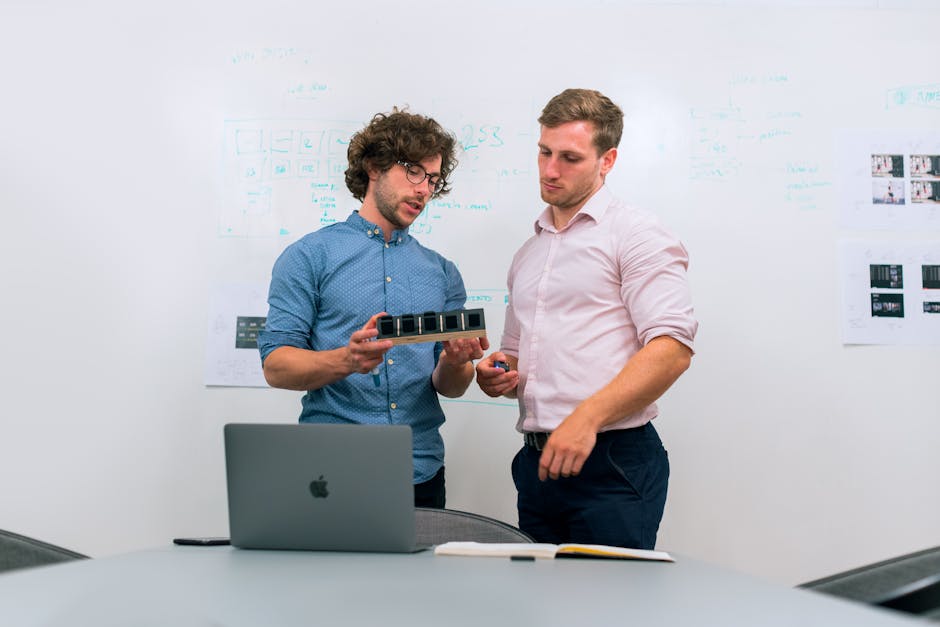Why Your Tech Start-up Should Adopt A ‘Useability MVP’ Approach
Did you know that 90% of start-ups fail within the first few years? As a tech entrepreneur, this statistic may sound alarming, but there is a way to improve your chances of success. By adopting a ‘Useability MVP’ approach, you can set your tech start-up apart and increase your chances of creating a successful product.
In today’s competitive market, user experience plays a crucial role in determining the success of a product. Users expect intuitive interfaces and seamless interactions with technology. This is where the concept of Minimum Viable Product (MVP) comes into play. By prioritising useability in your product development process, you can ensure that your initial release meets the needs and expectations of your target audience.
But how do you achieve this? It starts with conducting thorough user research and testing to gain insights into what users truly want and need. From there, an iterative design process allows for continuous improvement based on feedback from real users.
By focussing on useability from day one, you can differentiate your start-up from the competition and create products that truly resonate with users.
In this article, we will explore why adopting a ‘Useability MVP’ approach is essential for the success of your tech start-up.
Key Takeaways
- Adopting a ‘Useability MVP’ approach can improve the chances of success for a tech start-up.
- User experience plays a crucial role in determining the success of a product.
- Prioritising useability from day one differentiates start-ups and resonates with users.
- Continuous improvement based on user feedback through iterative design leads to a successful product.
Understanding the Importance of User Experience

Understanding the importance of user experience is crucial if you want your tech start-up to thrive and create a meaningful impact on people’s lives.
User-centred design is at the core of creating a successful product that meets the needs and expectations of your customers. By focussing on improving customer satisfaction through an exceptional user experience, you can differentiate yourself from competitors and build a loyal customer base.
User-centred design involves putting the needs, preferences, and behaviours of your target audience at the forefront of your product development process. This means conducting thorough research to understand their pain points, desires, and goals. By gaining deep insights into your users’ motivations and behaviours, you can tailor your product to meet their specific needs.
Improving customer satisfaction is a key goal for any tech start-up because it directly impacts retention rates and word-of-mouth recommendations. When users have a positive experience with your product, they are more likely to become repeat customers and refer others to try it as well. On the other hand, if users struggle with useability or encounter frustrations while interacting with your product, they may abandon it altogether or leave negative reviews.
By adopting a user-centred design approach and prioritising user experience from the start, you can create a product that delights users and generates positive outcomes for both them and your business. A seamless user experience not only enhances customer satisfaction but also increases engagement levels, boosts conversion rates, and drives overall growth.
With this understanding in mind, let’s explore the benefits of a minimum viable product (MVP) in further detail…
The Benefits of a Minimum Viable Product (MVP)

Imagine how much more efficient and streamlined your business could be with a stripped-down, yet powerful, prototype that showcases the key features of your product. This is exactly what a Minimum Viable Product (MVP) offers to tech start-ups. By adopting a useability MVP approach, you can leverage the benefits of design thinking and lean start-up principles to create a product that meets the needs of your target audience while minimising costs and time-to-market.
A useability MVP focuses on delivering the core functionality and user experience of your product in its simplest form. It allows you to gather valuable feedback from users early on in the development process, enabling you to iterate and refine your product based on real-world usage scenarios. This iterative approach helps you avoid wasting resources on developing features that may not resonate with users.
To better understand the benefits of an MVP, let’s take a look at this comparison table:
| Traditional Product Development | Useability MVP Approach |
|---|---|
| Time-consuming development cycles | Rapid development iterations |
| High upfront investment | Lower initial cost |
| Features based on assumptions | Real user feedback informs feature development |
| Longer time-to-market | Faster time-to-market |
As you can see, prioritising useability through an MVP approach offers numerous advantages for your tech start-up. Not only does it allow you to release a functional prototype quickly, but it also ensures that future developments are guided by actual user feedback rather than assumptions.
Transitioning into the next section about prioritising useability in product development, it becomes clear that adopting a useability MVP approach is just one step towards creating products that truly meet users’ needs.
Prioritising Useability in Product Development

To truly prioritise useability in product development, you need to focus on creating a seamless user experience that captivates and retains your audience. This means adopting a user-centred design approach and paying close attention to user interface design. By putting the needs and preferences of your users at the forefront of your development process, you can ensure that your product is intuitive, easy to use, and enjoyable.
To achieve this, there are several key considerations to keep in mind:
-
Understand your users: Conduct thorough research to gain insights into who your target audience is, what their goals are, and how they currently interact with similar products. This will help you tailor your user interface design to meet their specific needs.
-
Simplicity is key: Keep your product as simple as possible by eliminating unnecessary features or complexities. A clutter-free interface will enhance useability and improve the overall user experience.
-
Consistency matters: Maintain consistency throughout your product’s interface by using familiar patterns, ikons, and terminology. This reduces cognitive load for users and allows them to easily navigate through different sections of your application.
By prioritising useability in this way, you’re more likely to create a product that resonates with users from the start. However, it’s not enough to simply assume what works – conducting user research and testing is essential to validate assumptions about user behaviour and preferences.
Transitioning into the next section about conducting user research and testing without explicitly stating ‘step,’ it’s important to gather feedback from real users in order to refine the useability of your product.
Conducting User Research and Testing

Start by gathering feedback from real users to refine the useability of your product – after all, ‘the proof of the pudding is in the eating.’ User feedback is crucial in ensuring that your tech start-up adopts a user-centric design approach.
By conducting user research and testing, you can gain valuable insights into how users interact with your product and identify areas for improvement.
User research involves observing and interviewing users to understand their needs, expectations, and pain points. This can be done through surveys, focus groups, or one-on-one interviews. By collecting this information directly from your target audience, you can gather insights that will inform the development of a more useable product.
Once you have gathered user feedback, it’s important to incorporate it into your product development process. This means iterating on your designs based on what you learn from real users. By continuously testing and refining your product based on user feedback, you can create a more intuitive and enjoyable user experience.
User testing is another important aspect of gathering user feedback. This involves having real users interact with prototypes or early versions of your product and providing their thoughts and opinions. By observing how users navigate through your interface or perform tasks, you can identify any useability issues or barriers they may encounter.
By incorporating user feedback into your design process, you can ensure that your tech start-up prioritises useability. Continuous improvement based on real user experiences will ultimately result in a more successful product.
Moving forward into iterative design and continuous improvement allows for further refinement of the useability MVP approach without compromising its effectiveness.
Iterative Design and Continuous Improvement

Embrace the power of iterative design and continuous improvement to enhance your product’s useability and drive its success. By adopting an iterative design approach, you can continuously refine and improve your product based on user feedback, ensuring that it meets the needs and expectations of your target audience.
Here are three reasons why embracing iterative design is crucial for the success of your tech start-up:
-
Rapidly respond to user feedback: Iterative design allows you to gather valuable insights from real users early in the development process. By incorporating their feedback into each iteration, you can address any useability issues or pain points they may have encountered. This not only improves the overall user experience but also increases customer satisfaction.
-
Minimise wasted resources: Instead of investing significant time and resources into developing a fully-featured product, an iterative approach enables you to release a minimum viable product (MVP) with core functionality. By gathering user feedback on this MVP, you can identify key areas for improvement before committing additional resources towards unnecessary features or functionalities.
-
Stay ahead of the competition: With technology evolving at a rapid pace, it’s important to keep up with market demands and user expectations. By continuously iterating on your product based on user feedback, you can stay one step ahead of competitors who may be slower in adapting their offerings to meet changing needs.
By incorporating iterative design principles into your tech start-up’s development process, you can create a product that truly resonates with users and sets itself apart from competitors.
In the next section, we will explore how differentiating your start-up with a focus on useability can lead to long-term success without sacrificing innovation or functionality.
Differentiating Your Start-up with a Focus on Useability

In the previous section, we explored the concept of iterative design and continuous improvement, highlighting its importance in the development of a successful tech start-up. Now, let’s delve into another strategy that can set your start-up apart from the competition: adopting a user-centric approach with a focus on useability.
By incorporating design thinking principles and placing the user at the centre of your product development process, you can create an MVP (Minimum Viable Product) that not only meets but exceeds user expectations. This approach involves understanding user needs and pain points early on, conducting thorough research and testing to inform your design decisions.
To help you understand how this user-centric approach can benefit your start-up, let’s take a look at a comparison between traditional product development methods and those focussed on useability:
| Traditional Product Development | User-Centric Approach |
|---|---|
| Features-driven | User-needs driven |
| Assumes users will adapt | Adapts to users’ needs |
| Limited feedback | Continuous iteration |
As depicted in the table above, adopting a user-centric approach allows for continuous iteration based on feedback from real users. Instead of assuming what features are necessary or expecting users to adapt to your product, you actively seek their input and make improvements accordingly.
By prioritising useability in your MVP, you create a product that is intuitive, easy-to-use, and caters specifically to your target audience’s needs. This not only enhances customer satisfaction but also increases adoption rates and promotes positive word-of-mouth referrals.
Differentiating your tech start-up with a focus on useability through a design thinking-led approach can be instrumental in gaining a competitive edge in today’s market. By putting users at the heart of your product development process and continuously iterating based on their feedback, you ensure that your start-up delivers an exceptional user experience that sets it apart from competitors.
Frequently Asked Questions
How can a ‘Useability MVP’ approach benefit a tech start-up?
A ‘Useability MVP’ approach benefits a tech start-up by prioritising user-centred design and useability testing. This improves the user experience, allowing for agile development and ultimately leading to a successful product.
What steps should be taken to prioritise useability in product development?
To prioritise useability in product development, start with user-centred design principles. Incorporate regular user feedback to understand their needs and preferences. This will ensure that your tech start-up creates products that are intuitive and meet customer expectations.
What are the key elements of conducting user research and testing?
For user research and testing, gather valuable user feedback to improve your product’s useability. Conduct useability testing to identify areas of improvement based on real user interactions.
How can iterative design and continuous improvement be implemented in a tech start-up?
To implement iterative design and continuous improvement in a tech start-up, actively seek user feedback throughout the agile development process. This ensures that you can make timely adjustments based on real user experiences and improve your product accordingly.
What strategies can a tech start-up use to differentiate itself with a focus on useability?
To differentiate itself with a focus on useability, a tech start-up can employ effective user engagement strategies and design thinking. By prioritising user needs and continuously improving the product, the start-up can create a user-friendly experience that sets it apart from competitors.
Conclusion
In conclusion, adopting a useability MVP approach for your tech start-up is crucial.
By prioritising user experience and conducting thorough research and testing, you can ensure that your product meets the needs of your target audience.
Through iterative design and continuous improvement, you can create a seamless and enjoyable user interface that sets your start-up apart from the competition.
So, don’t underestimate the power of useability – it’s the key to unlocking success in today’s competitive market.
Contact us to discuss our services now!
